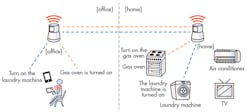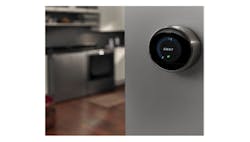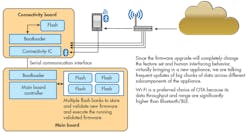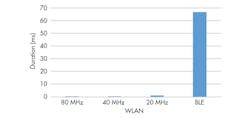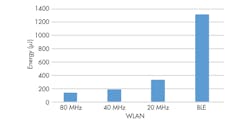Domestic Digitalization: Wireless in Home Appliances (Part 1)
Download this article in PDF format.
Many smart appliances are anything but smart. They use connectivity in a limited way to simply control appliances remotely. But the Internet of Things (IoT) enables us to implement much greater functionality than this.
Today’s consumer has a sophisticated perception of what living in a connected world means, and smart internet services have become far more mature than what was offered in first-generation connected white goods. Consumer expectations present an interesting challenge to the manufacturers and retailers of smart-home appliances, pushing them to innovate new capabilities and services.
All major appliance makers are gearing up to embrace the challenge and bring next-gen domestic digitalization to market. Internet and connectivity are no longer just add-on features; they are now at the very core of product positioning and brand extension to bundled services people hadn’t even imagined a few years back.
What Smart Services Can You Expect?
Controlling remotely: Cloud connectivity makes it possible to control appliances from outside of your residence. One example is the ability to review a real-time feed about room temperature in your house and switch on the air conditioner when you leave the office. Figure 1 shows another example of remote control.
1. Wireless remote control is enabled with a smartphone via Wi-Fi and the internet.
Intelligent assistance: Smart devices can have a say in how households are run by offering useful tips and helping consumers make informed decisions. For example, a connected refrigerator with freshness detection sensors inside its special compartments could indicate the freshness of the raw items stored in them. Using a relative freshness index and expected shelf-life of product, it could further guide users as to which items to use first. The fridge could also map food-to-use with recipes from partner websites and offer suggestions as to what to cook for dinner.
Ecosystem interoperability: An intranet of connected appliances together can form a cohesive ecosystem to build synergies between the appliances. For instance, once a user has chosen a recipe from the list suggested by the refrigerator, the refrigerator could notify the oven to set itself to the appropriate preheating conditions based on what’s about to be cooked.
Voice control: Voice controls like Apple’s Siri and Amazon’s Alexa are gaining popularity and acceptance, and are becoming widely used in kitchens (Fig. 2). Now, appliances can piggyback on these consumer electronics trends and enable seamless voice control. A user could, for instance, give voice instructions to the washing machine to start washing or the dryer to start drying.
2. Voice control by way of devices like Amazon Echo, Google Home and others is becoming more commonplace.
Replenishing: Devices can automatically issue replenish orders to e-commerce portals. Amazon has proven this functionality with its Dash buttons, which allow users to easily order, say, a specific SKU of detergent. Now appliances like washing machines can embed replenishing capabilities. In addition, the appliance can track the usage statistics and automate ordering.
Energy savings: Appliances can leverage the connected ecosystem to use electricity intelligently and take advantage of the lower usage rates. For example, a clothes dryer can sync up with a Nest learning thermostat (Fig. 3). Depending on your home and away modes, the dryer can then auto-delay laundry cycles until energy rush hours to optimize energy efficiency and rates.
3. Energy savings is one major benefit of wireless control and monitoring with devices like the Nest thermostat.
Service and repairing: One of the more compelling reasons to add cloud connectivity is for all-time machine status monitoring, enabling access to configuration tables to diagnose problems when they occur. For instance, when an appliance service person arrives for a service call, he or she is already informed about the problem. This significantly improves repair time and effectiveness. It also makes possible remote fixing of software problems through over-the-air (OTA) firmware upgrades.
Digital abstraction: An important part of digitization design is adding a software abstraction layer to differentiate capabilities and offerings so that the same underlying hardware chassis can be used across a product line. Consider services like Netflix and Amazon Prime, which have changed how TV is watched. Viewers watch what they want, when they want. An extension of such “pay for what you use” services can be adopted in home appliances as well.
For example, a consumer could upgrade from a simple wirelessly controlled oven to a voice-controlled version or even to one that can offer recipes ideas. Depending on the pricing policy, users could even downgrade services when they’re out of the home on vacation. In this way, consumers would be able to dynamically choose and customize the feature set of their appliances. Customization would be enabled using over-the-air firmware (FW) upgrades, which works seamlessly with WLAN compared to Bluetooth—a much slower link (Fig. 4).
4. Wi-Fi is the main wireless choice for over-the-air (OTA) upgrading of appliance firmware (FW).
The innovation challenge for developers is two-fold: Obviously, making different services possible and getting them to market quickly is important. But equally important is delivering top-notch connectivity performance. This is because the benchmark consumers will compare against appliances against is their connectivity experience with high-end consumer devices like smartphones and tablets, devices whose BOM is arguably much greater than that of home appliances.
Choice of Wireless Protocols
Many of the early connected appliances used Bluetooth (BT) or Bluetooth Low Energy (BLE) to communicate with smartphone and tablets. However, as the performance requirements increased, they soon migrated to WLAN, popularly called Wi-Fi. The reasons for this are clear: WLAN is ubiquitous, it forms the backbone of IoT infrastructure because of the widely installed router base at homes, and it provides the throughput and range for the need to implement Internet connectivity in the smart home.
5. The chart shows time of transmission for 10K of data for Wi-Fi (WLAN) and Bluetooth Low Energy (BLE).
6. This chart reveals the amount of energy used in the transmission of 10K of data for Wi-Fi (WLAN) and Bluetooth Low Energy (BLE).
The graphs in Figures 5 and 6 show a relative comparison of the latest WLAN and Bluetooth standards when used for transferring 10 kB of data. Note that WLAN (802.11ac) is roughly 200 to 300 times faster than BLE standards.
- Reduced airtime: Radio goes on and off much faster, causing less congestion of the ISM band
- Better battery life: Even though WLAN takes more power/bit, its higher throughput/ average power consumption is lower for larger data sets
This isn’t to say that Bluetooth is irrelevant for smart appliances. There are use-cases still better served by Bluetooth than WLAN, particularly after the advent of BLE. Thus, to provide seamless performance across a multitude of use case scenarios, a combination of both WLAN and BT/BLE that complement each other is a better choice for some appliances.
In the past, there were challenges of implementing Wi-Fi and Bluetooth together as they use the same 2.4-GHz band, and potential co-existence issues had to be addressed. However, today’s wireless suppliers have integrated solutions that support the concurrent operation of Bluetooth and Wi-Fi. For example, smartphones can stream music from the web using Wi-Fi and play it on a Bluetooth headset without any recognizable delay.
Look for more on Wi-Fi/Bluetooth in Part 2 of this article.

